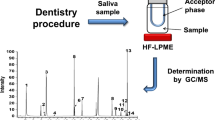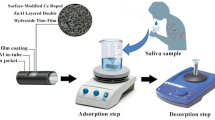Abstract
A new sample extraction procedure based on micro-solid-phase extraction (μSPE) using a mixture of sorbents of different polarities (polymeric reversed-phase sorbent HLB, silica-based sorbent C18, and multiwalled carbon nanotubes) was applied to extract benzene, toluene, butyraldehyde, benzaldehyde, and tolualdehyde present in saliva to avoid interference from moisture and matrix components and enhance sensitivity and selectivity of the ion mobility spectrometry (IMS) methodology proposed. The extraction of target analytes from saliva samples by using μSPE were followed by the desorption step carried out in the headspace vials placed in the autosampler of the IMS device. Then, 200 μL of headspace was injected into the GC column coupled to the IMS for its analysis. The method was fully validated in terms of sensitivity, precision, and recovery. The LODs and LOQs obtained, when analytes were dissolved in saliva samples to consider the matrix effect, were within the range of 0.38–0.49 and 1.26–1.66 μg mL−1, respectively. The relative standard deviations were <3.5 % for retention time and drift time values, which indicate that the method proposed can be applied to determine toxic compounds in saliva samples.

Summary of steps followed in the experimental set up of this work







Similar content being viewed by others
References
Bosker WM, Huestis MA. Oral fluid testing for drugs of abuse. Clin Chem. 2009;55:1910–31.
Gröschl MH, Topf HG, Rupprecht T, Rauh M. Evaluation of saliva collection devices for the analysis of steroids peptides and therapeutic drugs. J Pharm Biomed Anal. 2008;47:478–86.
Eiceman GA, Karpas Z. Ion Mobility Spectrometry. 3rd ed. Boca Raton: ᅟ; 2005. p. 33487–2742.
Armenta S, Blanco M. Pros and cons of benzodiazepines screening in human saliva by ion mobility spectrometry. Anal Bional Chem. 2011;401:1935–48.
Armenta S, Garrigues S, De la Guardia M, Brassier J, Alcalà M, Blanco M. Analysis of ectasy in oral fluid by ion mobility spectrometry and infrared spectroscopt after liquid-liquid extraction. J Chromatogr A. 2015;1384:1–8.
Sheibani A, Haghpazir N. Application of ion mobility spectrometry for the determination of tramadol in biological samples. J Food Drug Anal. 2014;22:500–4.
Criado-Garcia L, Ruszkiewicz DM, Eiceman GA, Thomas CLP. Rapid and non-invasive method to determine toxic levels of alcohols and hydroxylbutyric acid in saliva samples by gas chromatography-differential mobility spectrometry. J Breath Res. 2016;10:017101.
Jafari MT, Javaheri M. Selective method based on negative electrospray ionization ion mobility spectrometry (ESI-IMS) for direct analysis of salivary thiocyanate. Anal Chem. 2010;82:6721–25.
Mullett WM. Determination of drugs in biological fluids by direct injection of samples for liquid chromatograhic analysis. J Biochem Biophys Methods. 2007;70:267–73.
Harrington PD, Reese ES, Raunch PJ, Hu L, Davis DM. Interactive self-modeling mixture analysis of ion mobility spectra. Appl Spectrosc. 1997;51:808–16.
Mayer T, Borsdorf H. Accuracy of ion mobility measurements dependent on the influence of humidity. Anal Chem. 2014;86:5069–76.
Borsdorf H, Fiedler P, Mayer T. The effect of humidity on gas sensing with ion mobility spectrometry. Sensor Actuat B. 2015;218:184–90.
Jafari MT, Saraji H, Sherafatmand H. Polypyrrole/montmorillonite nanocomposite as a new solid phase microextraction fiber combined with gas chromatography-corona discharge ion mobility spectrometry for the simultaneous determination of diazinon and fenthion organophosphorus pesticides. Anal Chim Acta. 2014;814:69–78.
Jafari MT, Saraji H, Sherafatmand H. Electrospray ionization-ion mobility spectrometry as a detection system for three-phase hollow fiber microextraction technique and simultaneous determination of trimipramine and desipramine in urine and plasma samples. Anal Bional Chem. 2011;399:3555–64.
Jafari MT, Rezaei B, Zaker B. Ion Mobility spectrometry as a detector for molecular imprinted polymer separation and metronidazole determination in pharmaceutical and human serum samples. Anal Chem. 2009;81:3585–91.
Jafari MT, Badihi Z, Jazan E. A new approach to determine salicylic acid in human urine and blood plasma based on negative electrospray ion mobility spectrometry after selective separation using a molecular imprinted polymer. Talanta. 2012;99:520–6.
Basherr C, Alnedhary A, Madhava BS, Valliyaveettil S, Lee HK. Development and application of porous membrane-protected carbon nanotube micro-solid-phase extraction combined with gas chromatography/ mass spectrometry. Anal Chem. 2006;78:2853–58.
Stalikas CD, Fiamegos YC. Microextraction combined with derivatization. Trends Anal Chem. 2008;27:533–42.
Sergi M, Compagnone D, Curini R, D’Ascenzo G, Del Carlo M, Napoletano S, et al. Micro-solid phase extraction coupled with high-performance liquid chromatography-tandem mass spectrometry for the determination of stimulants, hallucinogens, ketamine and phencyclide in oral fluids. Anal Chim Acta. 2010;675:132–7.
Basheer C, Chong HG, Hii TM, Lee HK. Application of porous membrane-protected micro-solid-phase extraction combined with HPLC for the analysis of acidic drugs in wastewater. Anal Chem. 2007;79:6845–50.
Lucena R. Extraction and stirring integrated techniques: examples and recent advances. Anal Bional Chem. 2012;403:2213–23.
Boonjob W, Miró M, Segundo MA, Cerdà V. Flow-through dispersed carbon nanofiber-based microsolid-phase extraction coupled to liquid chromatography for automatic determination of trace levels of priority environmental pollutants. Anal Chem. 2011;83:5237–44.
Rodgman A, Perfetti T. The chemical components of tobacco and tobacco smoke. Florida: CRS Press; 2013.
Hoffmann D, Djordjevic MV, Hoffmann I. The changing cigarette. Prev Med. 1997;26:427–34.
Lashgari M, Basheer C, Lee KH. Application of surfactant-templated ordered mesoporous material as sorbent in micro-solid phase extraction followed by liquid chromatography-triple quadrupole mass spectrometry for determination of perfluorinated carboxylic acids in aqueous media. Talanta. 2015;141:200–6.
Acknowledgments
The authors are grateful to Spain’s DGICyT (Grant CTQ2014-52939R) for funding this work. L.Criado-García wishes to thank the Spanish Ministry of Education, Culture and Sport for the award of a pre-doctoral grant (AP 2009–3528).
Author information
Authors and Affiliations
Corresponding author
Ethics declarations
This study has been approved by the appropriate ethics committee and has been performed in accordance with the ethical standards.
Conflict of interest
The authors declared that they have no conflict of interest.
Rights and permissions
About this article
Cite this article
Criado-García, L., Arce, L. Extraction of toxic compounds from saliva by magnetic-stirring-assisted micro-solid-phase extraction step followed by headspace-gas chromatography-ion mobility spectrometry. Anal Bioanal Chem 408, 6813–6822 (2016). https://doi.org/10.1007/s00216-016-9808-1
Received:
Revised:
Accepted:
Published:
Issue Date:
DOI: https://doi.org/10.1007/s00216-016-9808-1




